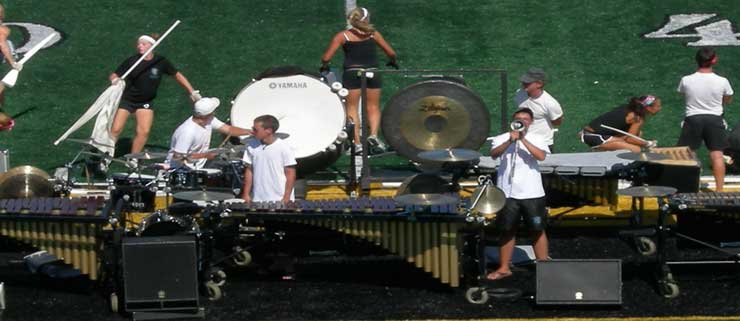 Learning chords can sometimes seem tedious and boring to
even the most dedicated guitarist. Most method books and other instructional
materials simply present endless pages of chord diagrams with little to no
explanation of how to put these chords into a practical, real world, situation.
Over the years, many teachers have developed creative ways to practice chords
that not only allow us to learn new voicings, but also teach us how to apply
these chords in everyday musical situations.
Learning chords can sometimes seem tedious and boring to
even the most dedicated guitarist. Most method books and other instructional
materials simply present endless pages of chord diagrams with little to no
explanation of how to put these chords into a practical, real world, situation.
Over the years, many teachers have developed creative ways to practice chords
that not only allow us to learn new voicings, but also teach us how to apply
these chords in everyday musical situations.
The following four exercises were derived from material presented in private lessons and master classes that I have taken with each musician.
Â
Roy Patterson: Chord Composition as a Practice Tool
- Pick a tune, preferably a jazz standard, and mark out four bars per line on a lead sheet.
- Write out two chord voicings per bar until all the bars are filled up. The voicings should be as close together as possible in order to promote proper voice leading.
- Each chorus of written voicings can be limited to a single type of voicing, Drop 2’s for example, or a certain extension, every chord has a 9th in it for example.
- Once all the voicings have been written out, learn to read through the etude along with a metronome or play along. After you can read through the etude at a reasonable tempo memorize it.
- Â Write out a second chorus, then third and so forth, each dealing with a new type of voicing or extension.
- After writing out and memorizing three to four choruses containing different types of chords, try and comp through the tune without writing out the voicings. It is surprising how many of the voicings will have crept into your playing without having to practice up and down inversions, or out of context exercises.
Jack Grassel: The Importance of Phrasing
- Pick a tune, the blues is a good starting point, and write out the chord progression, four bars per line, on a lead sheet. You will need at least 32 bars to complete the exercise, so if you use a blues write out at least 3 choruses of chord changes.
- Use slashes in place of the melody line as the focus of the exercise will be on the chords, not the tunes melody.
- Take a hi-liter, or similar marker, and mark the first five bars of the chord progression by drawing a line across the slashes.
- Leave the next four bars blank, then mark three bars with the hi-liter, then leave two bars blank, then mark one bar with the hi-liter.
- Repeat this process until all of the bars in your progression have been marked or left blank, in a similar fashion. I chose to start with 5 bars and count down, you could start on any number, and count up or down as you please. The goal is to have all the bars of the tune marked, or unmarked, in groups of varying lengths.
- Using a metronome, or play along, comp through the tune. Comp only where the bars have been hi-lighted, and rest on the bars that are blank. You can also do this in reverse order, comping in the blank bars and resting in the marked measures.
- You can also alternate types of voicings between the marked and unmarked bars. For example, you could play only Drop 2 chords in the marked bars and only 3rd and 7th voicings in the unmarked bars, or any combination of voicings you can think of.
Roddy Ellias: Developing a Personalized Chord Vocabulary
- Pick a chord type and root to work on, for example Cmaj7.
- Write out the notes of that chord up to the 13th. For Cmaj7 the notes would be C E G B D F# A.
- Pick any 3 notes from the chord scale. It is good to have either the Root, C, third, E, or seventh, B in each voicing when first beginning this exercise. With experience you will be able to choose any notes from the chord scale to build voicings.
- Find as many ways to play those three notes across the entire neck. For example, if the three notes that you picked were C G A, you could play C on any string, G on any string and A on any string. The possibilities are almost endless with just three notes.
- Use open strings as much as possible. Open strings have a tonal quality that can add richness and contrast to any chord voicing.
- Document every voicing you find by writing them in a “chord dictionary†or journal. Even with just C G A you can easily fill a page of chord charts with different voicings, in different octaves across the neck.
- Repeat this exercise in all 12 keys, then with other voicing types such as 7th, m7, m7b5 etc. You can also do this exercise with four, five and six note chords as well.
- After a while you will have amassed a huge number of chord voicings in your dictionary. While you will probably only end up using a handful of these chords on any given tune, the mental exercise of building chords from scratch is immensely beneficial.
Fred Hersch: Harmonic and Melodic Voice Leading
- Pick a tune, an easy standard or blues are good to use when beginning this exercise. After you are familiar with the process you will be able to move onto harder tunes.
- Pick a note from the first chord to use as the starting melody note. If the first chord is Cmaj7 begin with a G for example.
- Play the G on the 1st or 2nd string, and then harmonize that note with a Cmaj7 voicing. For the melody note G, you could play EBCG for example.
- Find a note from the second chord of the tune to use as the melody note of the next chord. The only rule is that you CANNOT move more than a whole-tone in either direction. So if you used the G in the first chord, your options for the second chord would be F, F#, G, G# or A.
- After you have chosen the melody note for the second chord, harmonize it in a similar fashion as the first.
- Repeat these steps for every chord in the tune. Since this exercise involves a lot of brain work, start by working through the tune out of time, so no metronome. Once you get the hang of it put the metronome on really slow, and work your way through the tune in time.
Â
Â
These are only four exercises that we can do in order to spice up our chord practice. After these five exercises have become easy, feel free to develop new and creative chord exercises that can be added to a daily practice routine.
Â
Remember, practicing creativity will allow us to play creatively.
Â
Also, check out the first article in this series, Energizing Your Scales.







 Scroll down to view the comparison chart of over a dozen different portable digital audio recorders.
Scroll down to view the comparison chart of over a dozen different portable digital audio recorders.